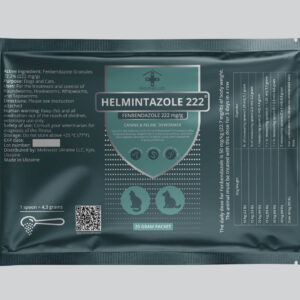Helmintazole 200 mg Animal Dewormer (Fenbendazole, Panacur), 100 g
Fenbendazole powder for oral use ● Anthelmintic, Antiparasitic, Dewormer
Active ingredient: Fenbendazole powder 200 mg/g
Consult your veterinarian for assistance in the diagnosis, treatment, and control of parasitism.
Drug Facts
Active ingredients (in each gram):
Fenbendazole Granules 20% (200 mg/g)
Purpose: Treatment of cattle, sheep, goats, pigs, horses, carnivores and fur-bearing animals, chickens, geese when infected with mature and immature forms of nematodes, some types of cestodes and trematodes and their eggs. Treatment of fish of the carp family with bothriocephalus.
Uses: For the treatment and control of Roundworms (Toxocara canis, Toxascaris leonina), Hookworms (Ancylostoma caninum, Uncinaria stenocephala), Whipworms (Trichuris vulpis), and Tapeworms (Taenia pisiformis).
Human Warning: Keep this and all medication out of the reach of children.
When using this product: Do not use simultaneously with antifasciological drugs, as well as for 7 days after treatment with bromsalanes.
Directions:
The daily dose for Helmintazole 200 is 50 mg/kg (22.7 mg/lb) of body weight. Please refer to the following dosing table for help in finding the right dose for your dog. A 2,5 – 5 ml measuring spoon is included.
*Kilograms to Pounds conversion table
| Kilograms (kg) | Pounds (lb) | Pounds+Ounces (lb+oz) |
| 0.1 kg | 0.220 lb | 0 lb 3.527 oz |
| 1 kg | 2.205 lb | 2 lb 3.274 oz |
| 5 kg | 11.023 lb | 11 lb 0.370 oz |
| 10 kg | 22.046 lb | 22 lb 0.740 oz |
Dosing Table (1 spoon per 3,2 gram of Fenbendazole 20% powder)
| Animal type | Disease | GR on 10 kg (22 lb) | Application |
| Cattle | dictiocaulosis, neoascaris, strongylosis,strongyloidiasis | 0,4 | once |
| trichurrhosis | 0,75 | 2 days | |
| paramphystomatidosis, dicrocoeliasis | 1 | 5 days | |
| cysticercosis | 1,25 | 3 days | |
| Sheep, goats | neoascaris, protostrongilidosis, strongyloidiasis, trichostrongyliasis, dictiocaulosis, moniesiosis, ticaniesiasis | 0,5 | once |
| trichurrhosis | 0,5 | 2 days | |
| larval cestodes: echinococcosis, pricerosis, dicrocoeliasis | 2 | 3 days | |
| Pigs | ascariasis, metastrongylus, trichurrhosis, esophagostenosis, olulanosis, strongyloidiasis | 0,5 | 2 times in 12 hours |
| Horses | parascarosis, intestinal strongyloidiasis | 0,75 | once |
| strongoidosis (stals) | 0,4 | 2 days | |
| Dogs, cats | ankylostomosis, capillaryosis, teniosis, trichurosis, toxascarosis, toxocarosis | 2 | 3 times in 12 hours |
| Fur animals | mixed non-matodose invasion | 0,5 | 3 days |
| Paultry | amidostomosis, ekinuriasis, capillaryosis, singamosis, streptocarosis, tetramerosis, ascaridiosis, heteracosis | 0,5 | 5 days |
| Fish | botriocephalosis | 1,25 | 2 days |
Storage: In a dry, dark place at temperatures from -30 to +30 °C (-22°F to 86°F)
Package: 25 gram Packet
FREQUENTLY ASKED QUESTION
So, the total amount is 100 g, and you give 2.5 for a 10-kilogram animal? What is 2.5 – is it 2g or 25g?
This is a bit confusing. Please help. Thanks.
The table shows data for every 10 kg of animal body weight. I understand that
your question is about the doses used to treat dogs and cats. For an accurate understanding,
Here are the following calculations:
Take, for example, a dog weighing 10 kg.
The dose of a single application is 2.5 grams. The procedure should be repeated three times every 12 hours.
2.5 g x 3 g = 7.5 g of the product that we need for a one-time treatment of one 10-kilogram dog
for ” Fenbendazole ”
100g: 7.5 = 13.33 times, one 10-kilogram dog can be treated with 100 grams
of “Fenbendazole”.
For a 5-kilogram dog, the calculation will look like this:
we will need 3.75 grams of the product for a one-time treatment of one 5-kilogram dog;
100: 3 = 26.26 times, one 5-kilogram dog can be treated with 100 grams
of “Fenbendazole”.
For a 50-kilogram dog, the calculation will look like this:
- 5×3 = 37.5 grams of product that we need for one-time treatment of one 50-kilogram dog;
100: 30 = 2.6 times, one 50-kilogram dog can be treated with 100 grams
of “Fenbendazole”.
How do I use the included measuring spoon? Thanks.
On the measuring spoon that is included in the kit, there are 2 labels: 2 ml and 5 ml.
5 ml of the drug weighs about 3-3.5 grams, 2.5 ml-1.5 grams, respectively.
For example, if you need to measure 1 gram, you can measure 3 grams first and then divide 3 grams of the drug into 3 equal parts, each of which will be equal to 1 gram. For example, if you need to measure half a gram, then you can measure 1.5 grams, and also divide 1.5 grams of the drug into 3 parts. Each part will contain 0.5 grams of the drug.






































































